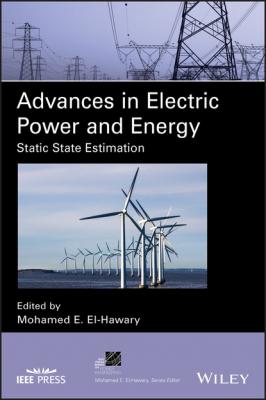Advances in Electric Power and Energy. Группа авторов
Читать онлайн.| Название | Advances in Electric Power and Energy |
|---|---|
| Автор произведения | Группа авторов |
| Жанр | Физика |
| Серия | |
| Издательство | Физика |
| Год выпуска | 0 |
| isbn | 9781119480440 |
If the general formulation (2.36) is to be recast as a mathematical programming problem, it is necessary to include (i) a binary variable vector b, (ii) a positive variable vector s, and (iii) two sets of constraints (2.37b). The resulting formulation (2.37) is a mixed integer nonlinear problem.
Again, the set of constraints (2.37e) of problem (2.37) can be relaxed, leading to a nonlinear problem, whose optimal solution generally meets constraints (2.37e).
2.5.5 Least Median of Squares
Least median of squares (LMS) is a robust estimator [2]. The objective function to be minimized is the squared measurement error whose value is the median of all squared measurement errors. The key idea underlying this technique is that the median of a set of values is a more robust estimate than the mean.
2.5.5.1 LMS General Formulation
The general formulation of the LMS estimator is
(2.38a)
subject to
(2.38b)
(2.38c)
(2.38d)
where the function median(x1, x2, …, xn) computes the median value of set {x1, x2, …, xn}.
Reference [25] proposes a mathematical programming formulation for LMS estimator to be applied to a linear estimator. In this chapter, this formulation is applied to the state estimation problem, and the mathematical programming formulation of LMS estimator is presented below.
2.5.5.2 LMS Mathematical Programming Formulation
The LMS mathematical programming formulation is
subject to
(2.39c)
(2.39d)
(2.39f)
where parameter M is a sufficiently large constant and parameter ν identifies the median and can be computed as [26]
where n is the number of state variables and function int(x) denotes the integer part of x.
The rationale for formulation (2.39) can be graphically explained. Figure 2.6 depicts the set of measurement errors yi(x), which are sorted by value. The colored zone is delimited by the bounds [−TLMS, TLMS] and includes the smaller measurement errors up to the position ν.
Figure 2.6 Graphical representation of the LMS estimator.
The objective function (2.39a) minimizes the variable TLMS, i.e. the width of the colored zone. The vector constraints (2.39b) and (2.39e) enforce that the number of measurements contained in the zone [−TLMS, TLMS] is equal to the parameter ν. The measurement residual yν(x) is thus at one edge of the interval [−TLMS, TLMS].
In formulation (2.39), note that the minimization of the median of squared errors corresponds to the minimization of the median of absolute errors.
The proposed mathematical formulation requires the addition of the following optimization variables: (i) a binary variable vector b whose values identify those absolute errors ∣yi( x)∣, which are smaller than or equal to ∣yν( x)∣, and (ii) a variable TLMS whose value is equal to ∣yν(x)∣. Three sets of constraints must also be included. Observe that the symbol TLMS represents a variable to be optimized, not a predefined parameter.
2.5.6 Least Trimmed of Squares
An alternative to the LMS estimator is provided by the estimator that minimizes the sum of the smallest ordered squared errors up to the position ν, the so‐called least trimmed of squares (LTS) estimator [3, 27].
2.5.6.1 LTS General Formulation
The general formulation of the LTS estimator is
(2.41a)
subject to
(2.41b)
(2.41c)
(2.41d)
(2.41e)
Note that the main difference between the LMS and LTS estimators is that the former considers only one squared
